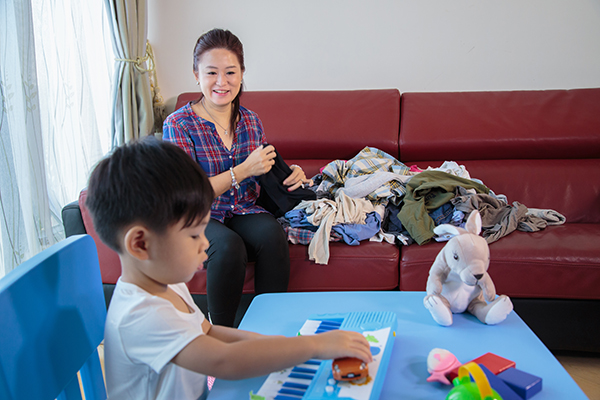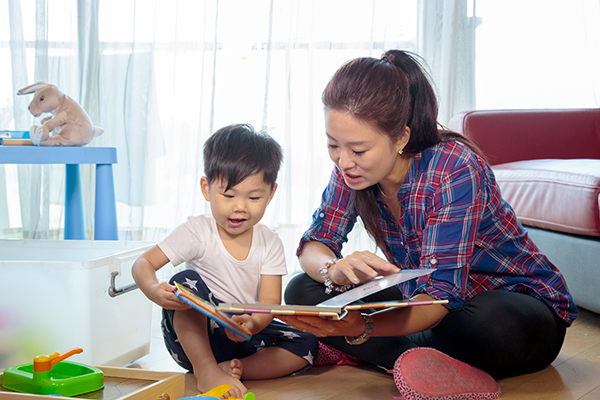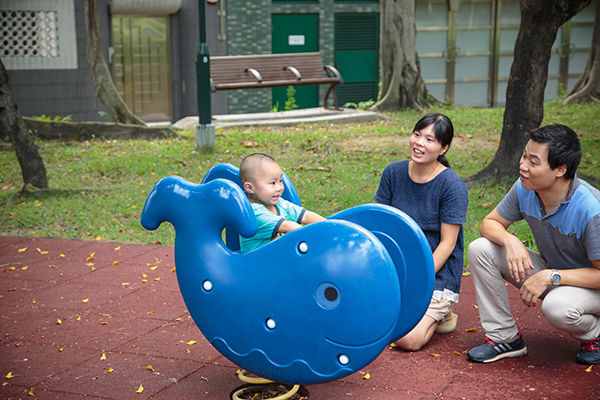Parent-child Communication Skills
Your children demand a lot of your time and attention. They want you to play with them and talk to them all the time. However, we are so occupied by work and household chores. No worries! Let's try “Quality time”.
- Give your child brief attention from time to time is better than spending a long duration with her.
- When she needs you, try to respond to her right away.
- Enjoy the time spent together with your child. It may feel silly, but do try to get down to her level in play and involve yourself totally.
The ‘quality time' you enjoy together will strengthen your bond and deepen her trust on you, setting the basis for effective parenting.
Parent-child Communication
Title: Parent-child Communication
Narrator: Parent-child Communication
Scene: Mum is playing a toy piano with her son Hei Hei in the living room.
Narrator: Mum is playing a toy piano with her son, Hei Hei, in the living room.
Scene: She glimpses the laundry on the sofa and rubs Hei Hei's head.
Narrator: She rubs Hei Hei's head and asks him to play with the toys as she has to do household chores.
Scene: Mum sits down and folds the clothes while Hei Hei is playing.
Narrator: Mum is folding the clothes while Hei Hei is playing.
Heading: Quality Time
Narrator: Quality time
Scene: Mum is playing with her son, Hei Hei, and doing household chores.
Narrator: Children often need our attention to chat and play with them. However, we may not always have time for them. If you make good use of “Quality Time” to build a good relationship with your children, they will trust you more and this makes parenting easier.
Scene: Mum is tickling Hei Hei on the sofa.
Narrator: Time spent with your child need not be long. Brief attention from time to time can have a better effect. Enjoy and tune in with your child even if the play seems to be silly and repetitive.
Scene: Mum is folding the clothes on the sofa. She smiles at Hei Hei and sings along the piano.
Narrator: Even if you are busy, you can give your child attention from time to time. Just like this mother, she often pays attention to her son and praises him while she is folding clothes.
Scene: Hei Hei goes to Mum while she is folding clothes at the sofa.
Narrator: Hei Hei goes to Mum while she is folding clothes. When your child needs you and comes to you, try to stop for a while whenever possible and respond to him.
Scene: Mum stops folding the clothes and talks to Hei Hei.
Narrator: Mum stops folding the clothes and responds to Hei Hei's needs.
Mum: Hei Hei, my dear! What's up? Mum is folding clothes.
Heading: Parent-child Communication Skills
Narrator: Parent-child communication skills
Scene: Scenes of Hei Hei throwing tantrums and Mum playing with him.
Narrator: Children of 18 to 24 months old may not express themselves well and are still self-centred. Using effective communication skills can help achieve two-way interactive communication with your child.
Scene: Hei Hei looks for his mother, but she is busy tidying up the table
Narrator: Mum is tidying up the table and holding the bowls while Hei Hei looks for her. She asks him to go and play on his own first.
Scene: Mum squats down, sits down and holds him to stay face-to-face while talking to him.
Sub-Heading: Face-to-face
Narrator: When talking to children, stay face-to-face at eye level with them. You can squat, sit down or hold them so that they can look right into your eyes.
Scene: Mum is playing with Hei Hei in the living room.
Narrator: When playing with children, don't just give them instructions and neglect their interests.
Scene: Mum picks a book and reads to Hei Hei. However, Hei Hei is more interested in other things.
Narrator: Mum suggests that Hei Hei reads a book. But seeing that Hei Hei is more interested in the cars, Mum lets him take the lead.
Sub-Heading: Let your child take the lead
Narrator: When you echo your child's interests, he will be more willing to communicate with you.
Scene: Mum and Hei Hei are playing balls in the living room.
Sub-Heading: Respond and praise
Narrator: When your child makes sounds, facial expressions or gestures, we can respond by imitating or guessing his meanings. Praise him for his efforts.
Scene: Mum passes the toys to Hei Hei and he puts them into the box.
Narrator: Hei Hei helps Mum tidy up the toys. After doing so, Mum praises Hei Hei with a big smile and applause.
Scene: Mum is playing with Hei Hei in the living room.
Sub-Heading: Talk about things in sight
Narrator: Make use of everyday situations to describe actions, names, uses or characteristics of things around your child to enhance his language and cognitive development.
Scene: Mum is bathing Hei Hei.
Narrator: Like at bath time, Mum says “Ducky” to Hei Hei while she holds a rubber duck.
Narrator: Mum describes what she's doing to Hei Hei while drying his body after a bath and helping him put on a shirt.
Scene: Mum is busy in the kitchen while Hei Hei is playing in the living room. Hei Hei looks for her.
Narrator: Mum is so busy in the kitchen and Hei Hei is playing in the living room. Then Hei Hei goes to her and Mum asks him to play on his own.
Scene: Hei Hei begins to throw a tantrum.
Sub-Heading: Prepare engaging activities
Narrator: If you are too busy to spare time with your child, do prepare in advance some interesting activities to engage him at such times so that he won't get bored and seek your attention.
Scene: Mum opens the kitchen cabinet trying to find some playthings for Hei Hei.
Narrator: Other than toys, durable household utensils can be fun! Remember, the most important thing is that they need to be appropriate to his developmental level.
Narrator: Mum brings Hei Hei some plastic bottles, boxes and paper tubes for him to play with.
Narrator: Children of this age have short attention span. You may retain the novelty of the activities for your child by preparing a variety of materials and putting away some for rotation. You really don't need to spend money on interesting toys!
End Shot: Department of Health logo
The Department of Health owns the copyright of this digital video.
This digital video is produced solely for non-commercial use.
It should not be rented, sold or otherwise used for profit-making purposes.
Children are still self-centred and lack in verbal expression ability at this stage. Your child may seem to ignore your instructions if you give instructions to him without taking into account his interest. Effective communication skills will be needed to achieve two-way interactive communication with your child.
| Effective skills | Remarks |
|---|---|
| Stay face-to-face | You can bend down or sit on the floor to adapt yourself to your child's height. |
| Let your child take the lead | Follow your child's interest and he will be more willing to communicate with you. |
| Talk about things happening within your child's sight | Describe names, the use or properties of objects and actions of people at anytime, anywhere to your child to enhance his language and cognitive development. |
| Respond and praise | When your child expresses himself by simple words, sound, facial expressions or gestures, respond to him by imitating or guessing his meanings. Praise any of your child's responses. |
Engaging Activities

Sometimes you may be too busy to spare even a brief moment with him. Make sure there are interesting objects or activities to engage him at such time so that he will have less chance to get into trouble. The activities should be interesting to him and appropriate to his developmental level. Other than toys, empty boxes, containers or durable household utensils can be fun and creative. You may retain the novelty of the activities for your child by preparing varieties of activities and putting away some of the materials periodically for rotation.


Refer to Playright's videos for more play ideas.
Avoiding Screen Time


From TV, video games, computers, smartphones to tablet computers, there are a wide variety of technology products. Many people consider screen-media learning an inevitable trend for children. However, the so-called “screen time” activities are largely sedentary and studies have shown that they are negatively associated with the well-being of children by having a tendency in:
- Decreasing children's amount of physical activity and lead to obesity.
- Compromising children's physical and language development.
- Leading to unhealthy eating habits.
- Creating chances for children to imitate inappropriate behaviours.
- Interfering with sleep quality, on-task attention, and social communication skills.
Hence, be a role model for your child and cut down screen time yourselves.
Useful tips:
- Children under 2 years old should avoid watching TV and coming into contact with any other screen-media, including “second-hand screen time”, when they can view the screen-media which the adults are using nearby.
- Spend time with children on reading, playing, talking, singing, dancing and physical activities, to replace screen time.


- Don't use screen-media as babysitter and don't leave the TV on in the background.
- Don't place TVs or computers in children's bedroom.
- Turn off the TV during mealtime to allow time for parent-child interaction.
- Don't leave smartphones or tablet computers at places easily reached by children.

